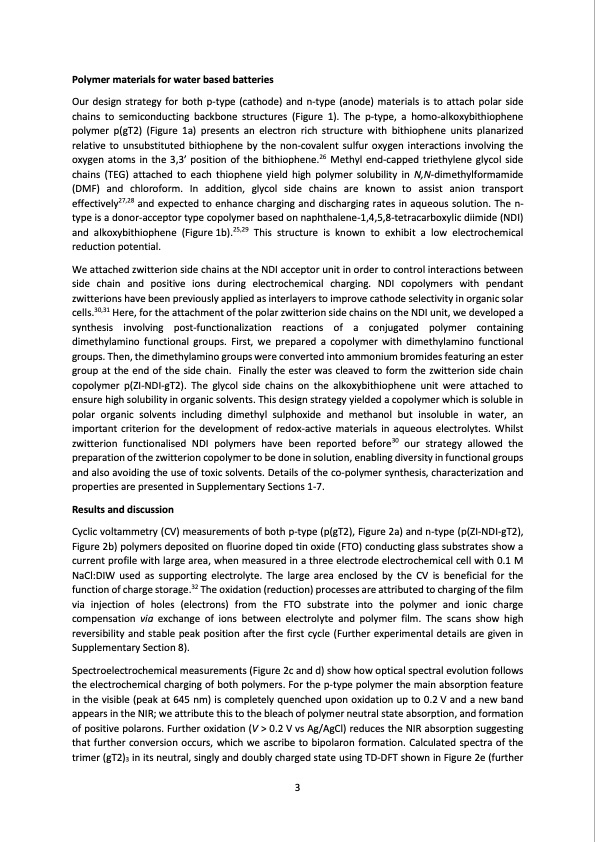
PDF Publication Title:
Text from PDF Page: 003
Polymer materials for water based batteries Our design strategy for both p-type (cathode) and n-type (anode) materials is to attach polar side chains to semiconducting backbone structures (Figure 1). The p-type, a homo-alkoxybithiophene polymer p(gT2) (Figure 1a) presents an electron rich structure with bithiophene units planarized relative to unsubstituted bithiophene by the non-covalent sulfur oxygen interactions involving the oxygen atoms in the 3,3’ position of the bithiophene.26 Methyl end-capped triethylene glycol side chains (TEG) attached to each thiophene yield high polymer solubility in N,N-dimethylformamide (DMF) and chloroform. In addition, glycol side chains are known to assist anion transport effectively27,28 and expected to enhance charging and discharging rates in aqueous solution. The n- type is a donor-acceptor type copolymer based on naphthalene-1,4,5,8-tetracarboxylic diimide (NDI) and alkoxybithiophene (Figure 1b).25,29 This structure is known to exhibit a low electrochemical reduction potential. We attached zwitterion side chains at the NDI acceptor unit in order to control interactions between side chain and positive ions during electrochemical charging. NDI copolymers with pendant zwitterions have been previously applied as interlayers to improve cathode selectivity in organic solar cells.30,31 Here, for the attachment of the polar zwitterion side chains on the NDI unit, we developed a synthesis involving post-functionalization reactions of a conjugated polymer containing dimethylamino functional groups. First, we prepared a copolymer with dimethylamino functional groups. Then, the dimethylamino groups were converted into ammonium bromides featuring an ester group at the end of the side chain. Finally the ester was cleaved to form the zwitterion side chain copolymer p(ZI-NDI-gT2). The glycol side chains on the alkoxybithiophene unit were attached to ensure high solubility in organic solvents. This design strategy yielded a copolymer which is soluble in polar organic solvents including dimethyl sulphoxide and methanol but insoluble in water, an important criterion for the development of redox-active materials in aqueous electrolytes. Whilst zwitterion functionalised NDI polymers have been reported before30 our strategy allowed the preparation of the zwitterion copolymer to be done in solution, enabling diversity in functional groups and also avoiding the use of toxic solvents. Details of the co-polymer synthesis, characterization and properties are presented in Supplementary Sections 1-7. Results and discussion Cyclic voltammetry (CV) measurements of both p-type (p(gT2), Figure 2a) and n-type (p(ZI-NDI-gT2), Figure 2b) polymers deposited on fluorine doped tin oxide (FTO) conducting glass substrates show a current profile with large area, when measured in a three electrode electrochemical cell with 0.1 M NaCl:DIW used as supporting electrolyte. The large area enclosed by the CV is beneficial for the function of charge storage.32 The oxidation (reduction) processes are attributed to charging of the film via injection of holes (electrons) from the FTO substrate into the polymer and ionic charge compensation via exchange of ions between electrolyte and polymer film. The scans show high reversibility and stable peak position after the first cycle (Further experimental details are given in Supplementary Section 8). Spectroelectrochemical measurements (Figure 2c and d) show how optical spectral evolution follows the electrochemical charging of both polymers. For the p-type polymer the main absorption feature in the visible (peak at 645 nm) is completely quenched upon oxidation up to 0.2 V and a new band appears in the NIR; we attribute this to the bleach of polymer neutral state absorption, and formation of positive polarons. Further oxidation (V > 0.2 V vs Ag/AgCl) reduces the NIR absorption suggesting that further conversion occurs, which we ascribe to bipolaron formation. Calculated spectra of the trimer (gT2)3 in its neutral, singly and doubly charged state using TD-DFT shown in Figure 2e (further 3PDF Image | salt water battery with high stability

PDF Search Title:
salt water battery with high stabilityOriginal File Name Searched:
salt-water-battery.pdfDIY PDF Search: Google It | Yahoo | Bing
Product and Development Focus for Salgenx
Redox Flow Battery Technology: With the advent of the new USA tax credits for producing and selling batteries ($35/kW) we are focussing on a simple flow battery using shipping containers as the modular electrolyte storage units with tax credits up to $140,000 per system. Our main focus is on the salt battery. This battery can be used for both thermal and electrical storage applications. We call it the Cogeneration Battery or Cogen Battery. One project is converting salt (brine) based water conditioners to simultaneously produce power. In addition, there are many opportunities to extract Lithium from brine (salt lakes, groundwater, and producer water).Salt water or brine are huge sources for lithium. Most of the worlds lithium is acquired from a brine source. It's even in seawater in a low concentration. Brine is also a byproduct of huge powerplants, which can now use that as an electrolyte and a huge flow battery (which allows storage at the source).We welcome any business and equipment inquiries, as well as licensing our flow battery manufacturing.| CONTACT TEL: 608-238-6001 Email: greg@salgenx.com | RSS | AMP |